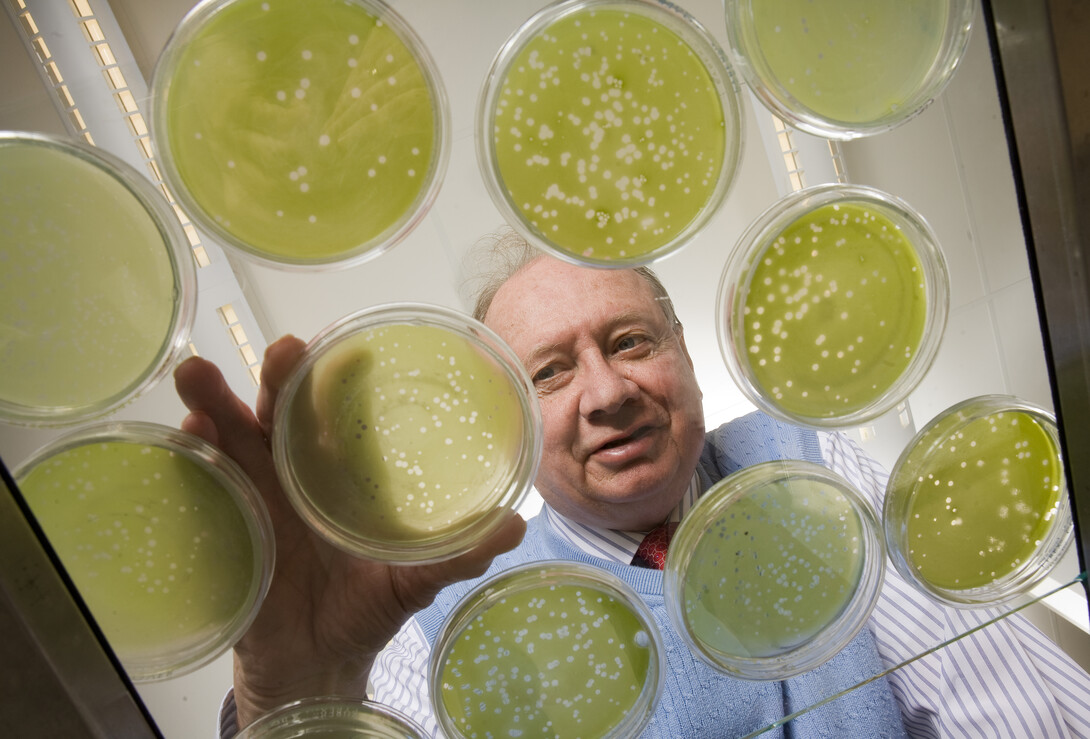
The DNA of a virus once thought confined to the cells of algae may in fact invade the biological kingdom of mice and men, according to a new study from researchers at Johns Hopkins and UNL.
The researchers, whose paper appeared Oct. 27 in Proceedings of the National Academy of Sciences, found DNA resembling that of an algae-native chlorovirus while taking throat swabs from healthy subjects during a study on cognitive functioning.
The discovery represents the first documented case of chlorovirus gene sequences in the human throat cavity, the researchers reported.
“Chloroviruses are worldwide,” said senior author James Van Etten, William Allington Distinguished Professor of Plant Pathology and a co-director of the Nebraska Center for Virology, who helped discover their existence in green algae more than 30 years ago. “They’re very common among inland bodies of fresh water such as lakes and ponds.
“But I don’t know of many examples of viruses jumping from one kingdom to another. If this turns out to be true, this is quite rare and a total surprise.”
Once subjects completed the original study’s cognitive assessments, the researchers also discovered that those participants carrying DNA of the chlorovirus – Acanthocystis turfacea chlorella virus 1, or ATCV-1 – performed measurably worse than those without it on tests of visual processing and spatial orientation.
“This is a striking example showing that the ‘innocuous’ microorganisms we carry can affect behavior and cognition,” said lead investigator Robert Yolken, director of the Stanley Neurovirology Laboratory at Johns Hopkins. “Many physiological differences between person A and person B are encoded in the set of genes each inherits from parents, yet some of these differences are fueled by the various microorganisms we harbor and the way they interact with our genes.”
To address the possibility that an unknown third variable might account for the link between ATCV-1 and cognitive deficits, the team also evaluated the effects of the chlorovirus on mice. The inoculated rodents exhibited similar deficits in recognition memory and attention while navigating mazes.
The study also found ATCV-1 altered the expression of genes in the rodent hippocampus, an area of the brain associated with memory and spatial navigation.
Van Etten said ATCV-1 and other chloroviruses feature about 400 genes, roughly 40 times more than better-known viruses such as HIV and influenza. Ironically, the relative size of these so-called “giant viruses” – combined with the rarity of “viral jumping” to another kingdom – likely contributed to them being overlooked, he said.
“People have conducted studies looking for more conventional viruses and bacteria in throat swabs, but the way those studies were done meant that they could have easily missed the ones that we work with,” Van Etten said. “Viruses are almost always thought to be very small. Researchers filter out other components when they’re identifying viruses, and chloroviruses are so big that they would’ve been caught in those filters.”
While emphasizing the need to further study the cognitive correlations of ATCV-1, Van Etten also indicated that the team is very interested in determining whether the chlorovirus can replicate in human and animal cells.
Van Etten’s collaborators on the study included UNL researchers David Dunigan, James Gurnon, Fangrui Ma and Irina Agarkova. In addition to Yolken, Johns Hopkins’ contributors included Mikhail Pletnikov, Lorraine Jones-Brando, Geetha Kannan, Emily Severance, Sarven Sabunciyan, C. Conover Talbot Jr., Emese Prandovsky, Flora Leister, Kristen Gressitt, Ou Chen and Bryan Deuber. Faith Dickerson of the Baltimore-based Sheppard Pratt Health System also served as a co-investigator.
The research was funded by the Stanley Medical Research Institute, the National Science Foundation and the National Center for Research Resources, part of the National Institutes of Health, under grant number P20-RR15635.







